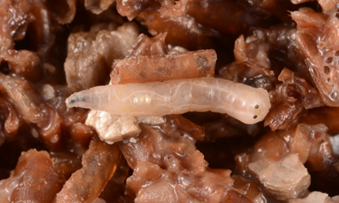MOJ
eISSN: 2574-9722


Research Article Volume 6 Issue 4
Biological Sciences, Parasitology, Instituto Federal Goiano, Brazil
Correspondence: Carlos Henrique Marchiori, Biological Sciences, Parasitology, Instituto Federal Goiano, Goiânia, Goiás, Brazil
Received: June 30, 2021 | Published: August 9, 2021
Citation: Marchiori CH. Occurrence of Stomoxys calcitrans L. (Diptera: Muscidae) in cattle feces collected on pasture. MOJ Biol Med. 2021;6(4):158-159. DOI: 10.15406/mojbm.2021.06.00149
Given the above this article aims to report the occurrence of Stomoxys calcitrans (Linnaeus, 1758) in cattle dung. The experiment was carried out at the Federal University of Goiás farm in Goiânia, GO, Brazil. Every fortnight, ten dishes black plastic containers containing bovine feces were exposed for fifteen days in the pastures. After this period, the feces were sent to the laboratory for pupae extraction. The experiments were carried out from April 2006 to December 2007. A total of 628 dipterans pupae were obtained from bovine feces, from which 8 specimens of S. calcitrans emerged from 8 pupae in bovine feces collected in pastures. The percentage of individuals collected was 1.3%.
Keywords: dipterans, fly, insect pests, animals, humans
Dipterans (flies) (Insecta: Diptera) are vectors of pathogens such as viruses, bacteria, protozoan cysts and parasitic worms. Can cause disease in animals and nuisance to humans both in the urban and rural environment.1 In the confinement and semi-confinement regime of animals, the accumulated manure constitutes an excellent means for the creation and development of several species of flies in rural environments. Although the excrements are periodically removed from the breeding sites, their permanence in manure houses favors the development of a very diversified entomofauna.2 The fly Stomoxys calcitrans (Linnaeus, 1758), commonly known as the “stall fly”, is a hematophagous fly that attacks several species, among which stand out cattle, goats, sheep, horses, dogs and even man. This fly is one of the most important dipterans for national livestock, due to the economic losses it causes and its role as a transmitter and potential vector of various diseases to domestic animals.3,4
Given the above this article aims to report the occurrence of S. calcitrans in cattle dung in pastures.
The experiment was carried out at the Federal University of Goiás farm in the central region of Goiás, Brazil. Every fortnight, ten dishes black plastic containers (Figure 1) containing bovine feces were exposed for fifteen days in the pastures. After this period, the feces were sent to the laboratory for pupae extraction. Pupae were removed with the aid of a sieve, counted and stored individually in glass jars. The flies that emerged were identified morphologically. The experiments were carried out from April 2006 to December 2007.
A total of 628 dipterans pupae were obtained from bovine feces, from which 8 specimens of S. calcitrans (Figures 2 & 3) emerged from 8 pupae in bovine feces collected in pastures. This species is found preferentially in feces put in stables, corrals and other places. The pastures were approximately 500, 100 and 10 meters from the stables and corrals. The feces were in places that the animals did not have access to. The presence of ewes near the stables was noted only once during the study.

Figure 2 Stable fly, Stomoxys calcitrans (L.), maggot (larva). Photograph by Lyle Buss, University of Florida.

Figure 3 Stable fly, Stomoxys calcitrans (L.), pupae. Source: Photograph by Lyle Buss, University of Florida.
The percentage of individuals collected was 1.3% (8/628) low due to its high degree of synanthropy. Stomoxys calcitrans have most animals and humans as hosts, and their bite is painful. Food remains and vinasse, a by product of the sugarcane industry, attract and stimulate posture, as well as can be formed in straw and harvest residues, which remain for some time in the field, especially if these materials are fermented or moistened with urine and animal feces.5
Stomoxys calcitrans is a fly that belongs to the muscidae family, which is distributed worldwide. It is responsible for transmitting various diseases to domestic animals (Figures 4, 5 &6).
None.
None.

©2021 Marchiori. This is an open access article distributed under the terms of the, which permits unrestricted use, distribution, and build upon your work non-commercially.